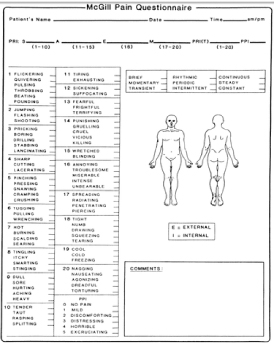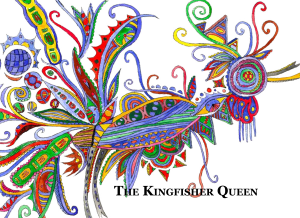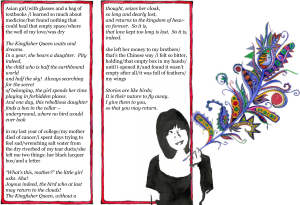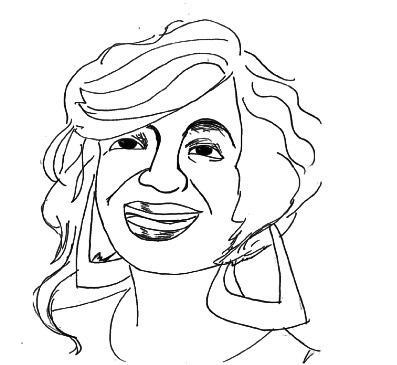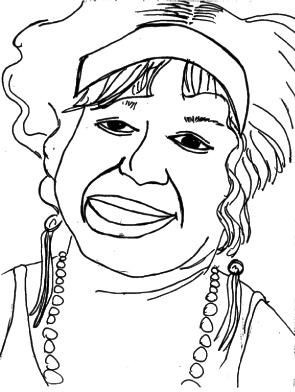mickael chacha enriquez, billy hébert, line chamberland et jean dumas
(((Mickael Chacha Enriquez est étudiant-chercheur engagé, allié à la cause trans, qui rédige actuellement son mémoire de maîtrise sur la militance trans au Québec (UQAM). Il est adjoint de recherche à la Chaire de recherche sur l’homophobie, où il coordonne un projet de recherche-intervention auprès des aîné-es trans en partenariat avec l’Association des Transsexuels et Transsexuelles du Québec.
Billy Hébert est chargé de projet au sein de l’initiative SIRA – Aîné-es Trans, un projet québécois de recherche et d’intervention sur les besoins et expériences des personnes transsexuelles et transgenres de 50 et plus dans les milieux de la santé et des services sociaux. Il a obtenu une Maîtrise en Anthropologie sociale et culturelle à l’Université Concordia de Montréal au printemps 2012. Étant intéressé à concilier recherche académique et militantisme, il se considère comme un chercheur « engagé » qui désire participer à des projets ayant pour but de contribuer à l’empowerment des groupes marginalisés.
Militante de longue date et sociologue de formation, Line Chamberland a réalisé plusieurs études sur les discriminations envers les minorités sexuelles dans divers contextes de vie : écoles, milieu de travail, services sociaux et de santé. On lui doit aussi un grand nombre de publications sur l’histoire du lesbianisme au Québec ainsi qu’en études gaies et lesbiennes. Depuis novembre 2011, elle est titulaire de la Chaire de recherche sur l’homophobie de l’UQAM, laquelle veut établir des ponts entre les milieux institutionnels, communautaires et scientifiques afin de lutter plus efficacement contre l’homophobie, la lesbophobie, la biphobie et la transphobie.
Jean Dumas est titulaire d’un doctorat en communication à l’UQAM. À partir de 2007, il a travaillé comme adjoint de recherche dans l’équipe Sexualités et genres: vulnérabilité, résilience de l’UQAM, sur les usages d’Internet liés à la santé parmi les minorités sexuelles LGBT (les personnes lesbiennes, gaies, bisexuelles et transgenres). Il est actuellement stagiaire postdoctoral au CSSS Jeanne-Mance dans le cadre d’un projet visant l’évaluation de l’adéquation des services de sociaux et de santé avec les besoins en matière de santé des minorités sexuelles.)))
Lors de la conférence Étude en Action, 2012 Mickael Chacha Enriquez a présenté le contenu ci-dessous pendant la table ronde intitulé: Santé, recherche et ressources transgenre.
J’ai décidé de présenter un survol de deux recherches trans menées actuellement à l’Université du Québec à Montréal (UQAM): l’une sur les aîné-es trans, l’autre sur les usages d’Internet pour des informations en santé. Ainsi, je ne vais pas aller en profondeur, je me contenterai de partager avec vous quelques éléments de ces recherches, afin de montrer en quoi elles sont utiles aux communautés trans. Cela me permettra de montrer l’importance d’inclure des personnes et organismes trans dans ces recherches.
I. les aîné-es trans
Le premier projet a pour but d’améliorer les conditions de vie des aîné-es trans. Il est issu d’un partenariat entre l’Aide aux Transsexuels du Québec (ATQ) et la Chaire de recherche sur l’homophobie (UQAM), et est subventionné par le ministère de la Famille et des Aînés. Le projet est constitué d’un an de recherche et d’un an d’intervention. Il s’agit de la première recherche de cette envergure sur les aîné-es trans au Canada.
Ce projet part des préoccupations de cette première génération d’aîné-es trans, qui partagent de nombreuses craintes face au vieillissement, comme nous l’ont rapporté les différents organismes impliqués (ATQ, Astt(e)Q et Iris-Estrie). Ces organismes apportent une aide très importante pour la recherche, notamment lors du recrutement des participant-es. En effet, beaucoup d’aîné-es trans ne fréquentent plus ces organismes ou vivent en dehors des grands centres urbains. Sans le soutien de plusieurs membres de ces organismes, nous n’aurions pas pu avoir un échantillon si diversifié. Nous avons interrogé 12 aîné-es trans, dont la moitié vivent en dehors des grands centre urbains. Par ailleurs, deux hommes trans ont été interrogés, ainsi que deux femmes d’origine latino-américaines.
Un autre défi de la recherche de terrain était de créer un cadre de confiance avec les personnes trans rencontrées. Plusieurs ont fait leur transition dans les années 1970, 1980 ou 1990. Ayant connu une marginalisation sociale autrement plus forte qu’aujourd’hui, beaucoup sont habituées à filtrer ce qu’elles disent par crainte du jugement des autres. On s’est rendu compte que quand l’intervieweur disait qu’il était trans lui aussi, les langues se déliaient beaucoup plus, car un lien de confiance avait été créé ou s’était aussitôt établi.
Ces deux éléments montrent à quel point il est important que la recherche trans soit menée en partenariat avec des organismes trans et que des personnes trans soient inclues dans les équipes de recherche.
Puisque lors de la présentation nous n’avions pas encore commencé les analyses, la section suivante donne quelques résultats préliminaires de la recherche de terrain.
1. refus de traitement et impact sur la confiance des patient-es trans plus âgé-es envers les professionnel-les de la santé.
Lolita, 58 ans, a débuté sa transition (le processus émotionnel et/ou physique lors duquel une personne se perçoit et est perçue comme changeant d’identité de genre, et qui peut inclure des aspects sociaux et médicaux, comme par exemple le changement de nom, la prise d’hormones et certaines chirurgies) il y a plus d’une quinzaine d’années et vit « stealth » (sans parler de son passé de transition) depuis un bon moment. Elle a eu une vaginoplastie (chirurgie dite de « réassignation sexuelle ») il y déjà plusieurs années, mais n’a pris des hormones qu’au tout début de sa transition. Elle lie cet arrêt au refus d’un endocrinologue de continuer à lui prescrire des hormones parce qu’elle est fumeuse, bien que les risques y étant associés sont selon elle négligeables. Cette expérience, dans ses mots, l’a fait « décrocher du système de santé ». Malgré cela, après quelques années, elle est retournée voir un médecin afin d’avoir un suivi médical. Cette professionnelle de la santé lui a offert de faire une cytologie, un examen gynécologique consistant en une analyse des cellules du col de l’utérus. Lolita raconte l’échange qui a suivi cette demande du médecin : « J’ai dit : “Je suis une femme trans”. Elle m’a dit : “Moi, je traite pas ça!” » Lolita a donc eu un refus de traitement. Elle est récemment entrée en contact avec d’autres personnes trans, afin d’avoir un meilleur réseau de soutien et les coordonnées de professionnel-les sensibilisé-es.
2. relation positive établie avec un-e professionnel-le de la santé
Pierre, un homme trans de 59 ans dont la transition médicale a aussi été entamée il y a de nombreuses années, avait un médecin traitant qui a pris sa retraite. Il s’est alors tourné vers le médecin de famille de sa conjointe, elle aussi trans. Cela fait maintenant 17 ans qu’il voit cette professionnelle de la santé. Il préfère se déplacer à 45 min de son domicile (de la banlieue montréalaise à Verdun), puisqu’il considère ne pas recevoir des soins adéquats dans les services de santé de sa région. Pierre a développé un très bon rapport avec cette professionnelle. Il lui a révélé être un homme trans après quelques visites, alors qu’elle devait lui faire un examen physique général. La réaction de ce médecin a été, selon lui, très professionnelle – elle n’a fait aucune remarque déplacée au sujet de la transidentité de Pierre et n’a pas eu de réaction de surprise ou de curiosité, ce qui a mis ce dernier en confiance. Pierre raconte que son ancien médecin ne lui avait jamais proposé de faire un examen gynécologique, en partie car il n’est lui-même pas à l’aise avec ce type de situation. Pourtant, son nouveau médecin a insisté sur la nécessité d’une telle procédure bien que Pierre niait en avoir besoin – elle lui a rappelé que c’est son rôle en tant que professionnelle de la santé de lui faire passer les tests adéquats. Cet examen s’est finalement très bien passé.
3. quand une professionnel de la santé aide une femme trans à faire sa transition
Julie a 67 ans, elle a entamé sa transition il y a un an, et ce, grâce aux conseils d’une psychologue qu’elle voyait pour des problèmes d’alcoolisme en région. Cette psychologue la soutient beaucoup dans toute sa démarche. Julie vit maintenant à Montréal pour pouvoir « vivre ce qu’elle a à vivre ».
4. les aîné.es trans développent aussi des stratégies
Céline a 59 ans, elle a entamé sa transition il y a plus de 20 ans. Elle a développé une stratégie afin de passer ses examens de la prostate sans être stigmatisée dans la salle d’attente. Elle vient toujours accompagnée d’un ami homme, pouvant ainsi passer pour sa femme. Cela lui permet d’éviter de dévoiler qu’elle est une femme trans lorsqu’on l’appelle dans la salle d’attente – ce type de stratégies peut aussi être employé par les personnes trans dont les papiers d’identification ne reflètent pas leur identité de genre.
Un rapport de recherche exhaustif sera produit dans l’année à venir, soit d’ici au printemps 2013. Grâce à cette recherche, un dépliant, un atelier de sensibilisation et des outils pédagogiques seront également développés. Ils permettront de sensibiliser les intervenant-es de la santé et des services sociaux aux besoins et aux éléments facilitant l’accès des aîné-es trans à leurs services. Il s’agit donc d’un projet qui aidera à améliorer les conditions de vie des aîné-es trans.
II. les usages santé d’Internet parmi les personnes trans au Canada
La seconde recherche utile aux communautés trans est celle sur les usages santé d’Internet par les LGBT (Lesbiennes, Gais, Bis, Trans), dirigée par Joseph Levy du département de sexologie de l’UQAM. Il y a eu un effort d’intégration des personnes trans dans cette recherche, notamment en consultant certaines d’entre elles qui ont donné des conseils quant à la formulation des questions. Je dois préciser qu’aucune recherche n’a été repérée concernant spécifiquement les usages santé trans d’Internet. Au total, 2187 personnes ont répondu au sondage en ligne parmi lesquels 135 personnes ont répondu à la question « quel est votre sexe ou votre identité de genre? » par « une personnes transgenre ou avec une identité de genre non-conforme ».
Je ne suis pas entré dans les chiffres précis lors de la présentation, mais plutôt simplement exposé quelques éléments saillants. En comparant les réponses de ces 135 répondant-es trans aux autres répondant-es cis LGB, on voit que les personnes trans interrogées :
– sont plus nombreuses à rechercher de l’information sur la santé via le Web et le font à une plus grande fréquence;.
– ont tendance à privilégier des outils plus interactifs, comme les forums de discussion, les échanges de courriels avec des professionnel-les de la santé ou des intervenant-es communautaires, les blogues et les sites de réseautage;
– priorisent des thèmes de recherches en lien avec la transition (hormonothérapie, interventions chirurgicales, etc.);
– discutent plus de l’information trouvée avec des personnes de leur entourage, en ligne avec des inconnus ou avec des médecins, d’autres professionnel-les de la santé ou des intervenant-es communautaires;
– ont une satisfaction moins grande par rapport à l’information obtenue, jugée moins facile à trouver, moins sérieuse, moins crédible, moins exacte, moins complète et moins facile à comprendre.
On remarque également que malgré le manque de satisfaction quant à l’information trouvée, celle-ci a un impact similaire à ce qui est observé chez les LGB cis, voire plus élevé : elle a davantage modifié leur façon de penser sur leur identité de genre, leur orientation sexuelle et leurs relations interpersonnelles et sociales. Elle leur a également permis, plus qu’aux personnes cis, de poser de nouvelles questions à leurs professionnel-les de la santé ou d’obtenir une seconde opinion.
Cette recherche montre que les personnes trans sont d’importants utilisateurs de la e-médecine, qui appelle à une reconfiguration du lien entre médecin et patient en leur permettant de constituer leur propre expertise1.
Un poster est disponible et un article est actuellement en rédaction, avec les détails des données. Cette recherche est utile aux communautés trans, car elle démontre qu’elles ont un grand besoin en ressources d’information concernant la santé trans disponibles sur Internet. Cette recherche va, par exemple, pouvoir servir de point d’appui à un organisme communautaire, afin de rédiger une demande de subvention pour développer un site internet en lien avec des professionnel-les de la santé et des intervenant-es communautaires en santé trans.
III. Conclusion
On remarque ces dernières années un développement important de la recherche trans à l’UQAM. De plus en plus d’étudiant-es s’intéressent à la question et mènent des recherches sur le sujet, et cela risque de continuer à évoluer dans ce sens. Pour terminer, il faut insister sur l’importance d’intégrer des personnes trans au sein des équipes de recherche LGBT et de mettre en place des mécanismes de consultations et de collaboration avec les organismes trans.
endnote
1. Hardey, M. (2004). « Internet et société : reconfiguration du patient et de la médecine ? », Sciences sociales et santé, vol. 22, no 1, p. 21-43.

